-
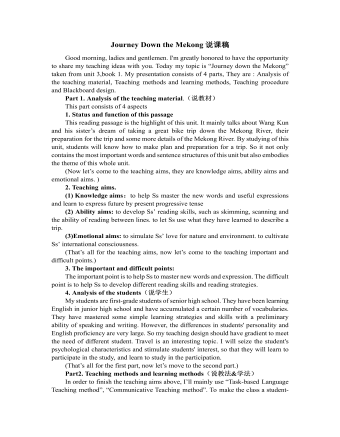
人教版高中英语必修1Journey Down the Mekong说课稿
2. let the Ss complete the forms paragraph by paragraph. Purpose here is to help Ss to get the habit of reading a passage as a whole, and pay attention to the organization of the text, as a result the Ss will fully understand the whole passage.3. ask Ss to retell the passage with the help of the key words in the form.Since the Ss in the class are in different levels, so I let them to fill in the blank to understand the meaning of the words and phrases better. ( That’s all for the while-reading. Now let’s move to the fifth step.)Step V: Post-reading (10mins) ---DiscussionIn this part students are asked to discuss in groups and list Wang Kun’s and Wang Wei’s attitudes about the trip. After that, Ss are encouraged to express their attitudes with the whole class. Collect their answers and don’t forget to praise them even if their answers may not be perfect.In this activity, discussion provides a vivid and active learning environment for Ss to communicate in English with newly learned language items. (Finally it comes to the homework.)StepⅥ: Homework (1min)1. Ss are required to read the text again after class and figure out the meaning of some complex sentences.2. Do the exercises on P19; This can help Ss to consolidate what they’ve learnt and make preparation for the next lessonPart4. Blackboard design.(说板书设计)On the top, there is the title of this lesson. On the left, there are main ideas for each paragraph. On the right, there are some new words and expressions.Unit 3 Travel journalJourney down the MekongMain idea of each para.:Para1: deciding to take a great bike trip along the Mekong river.Para2: Different attitudes between Wang kun and Wang wei.
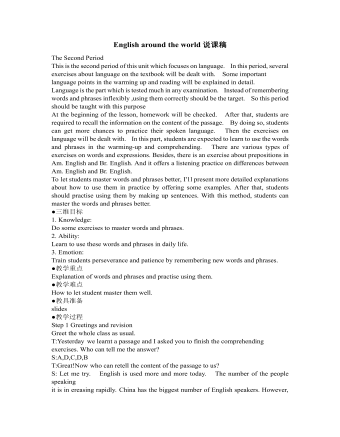
人教版高中英语必修1English around the world说课稿
(3)v. 给:提出;展现,显现present sb. with sth. ; present sth. to sb. 把. . 交给;颁发;授予present sth. (for sth. )/present sth. to sb. e. g. Om his birthday, his friends presented him a collection of stamps. 在他生日时,他的朋友们送给他一套邮票作为礼物。The sword was presented by the family to the museum. 这家人把宝剑捐赠给了博物馆。The committee will present the final report to Parliament in June. 委员会将在六月向议会提交最后的报告。You need to present yourself better. 你需要更善于展现自己。It is essential that we present a united front. 至关重要的是我们要表现得更加团结。Step 4 ConsolidationT:Now that we have got a general idea of these words and phrases. Lets make up some sentences using them to master them. Suggested sentences:1. Your duties include typing letters and answering the telephone. 2. It is one of the greatest roles that she has played. 3. A large number of people have applied for the job. 4. The number of the panda is declining. 5. I'11 go there, even if I have to walk. 6. He came up to me to ask for a light. 7. The novel is about a family who can't communicate with each other. 8. He based his plan on interests of most people. 9. Why doesn't he make use of his singing talent?Step 5 Summary and homeworkT:Today we dealt with several new words and phrases. After class I hope that youcan read them again and again to keep them in mind. That's all for today. You aredismissed.
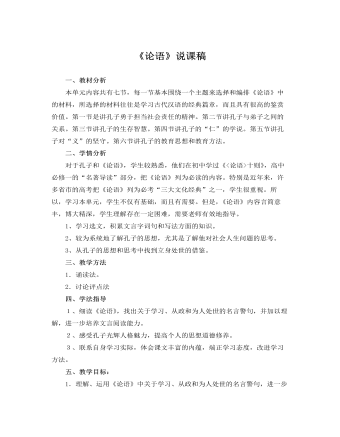
人教版高中语文必修1《论语》说课稿
三、文本中的句子解决完毕,大家对文本内容的理解更加深入了。请速度文本,思考:《论语》具体涉及了哪些方面的内容,体现了孔子什么观点?明确:主要有治学、从政、修身养性和交友治道等方面,体现了孔子“克己复礼”的思想。四、 教师引导学生讨论: 如何评价孔子的言行和观点?从古至今人们对孔子有哪些评价?明确:1、春秋战国时代, 孔子门人及其后学者均推尊孔子。门人中以子贡为代表,他对孔子赞美备至,奉如天人,把孔子比拟为高天、日月、木铎,凡人是永远不可企及的,认为孔子是天生的圣人,“仰之弥高,钻之弥坚”。亚圣孟子认为孔子所行的“圣人之道”是遍及自然界和社会的至高准则。然而当时民间一般看法认为孔子是博学成名的大学者。

人教版高中历史必修3辉煌灿烂的文学说课稿
教师:不同的时代造就了不同风格和不同精神内容的诗词,请同学们回顾必修一和必修二两宋中央集权的加强和经济的发展状况。学生:回忆回答。教师:请同学们结合时代背景和词的特点理解词为什么能够成为宋代文学的主流形式和标志?学生:两宋时经济重心转移到了南方,商业发展打破了时间和空间的限制,城市繁荣,市民数量不断增加。词的句子长短不齐,便于抒发感情,并且能够歌唱,更能适应市井生活的需要。于是,词成为宋代文学的主流形式和标志。教师:宋代文人地位提高,宋词就是一个个时代的画卷:大宋的悲欢离合都写在了里面。除了词之外,宋代民间还兴起了一种新的诗歌形式,即散曲。学生:回答散曲的发展阶段及特点、元曲的含义、特点。教师:在中国古代诗歌辉煌发展的同时,也产生了供人们闲来无事消遣的小说。
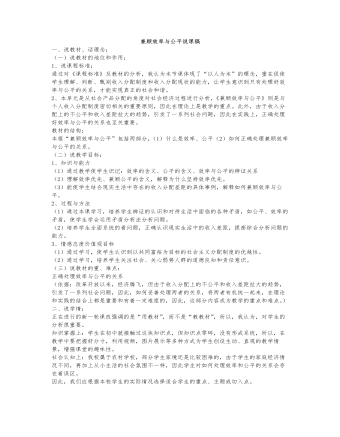
人教版高中政治必修1兼顾效率与公平说课稿
(3)如何做到兼顾效率与公平?这部分知识点我结合上面的图片,设疑:“请大家对这一社会现象进行讨论,我们如何才能做到既坚持效率又兼顾公平?”导入这部分的分析。学生在讨论的过程中对如何兼顾效率与公平已经形成了一定的见解,结合图片,为兼顾效率与公平献计献策,寻求两者的最佳结合点。幻灯片展示:怎样才能做到兼顾效率与公平?第一,允许和鼓励一部分地区和个人通过诚实劳动和合法经营先富起来,带动其他地区和个人致富,最终达到共同富裕。第二,既要反对平均主义,又要防止收入差距悬殊。既要落实分配政策,又要提倡奉献精神;在鼓励人们创业致富,提倡回报社会和先富帮后富。第三,必须正确处理初次分配注重效率与再次分配注重公平的关系。在讲授过程中,还展示大量图片。结合图片分析。设计意图:体现课堂上学生的主体地位,让学生在观看中体验,在讨论中升华,从而体会构建和谐社会的重要意义。
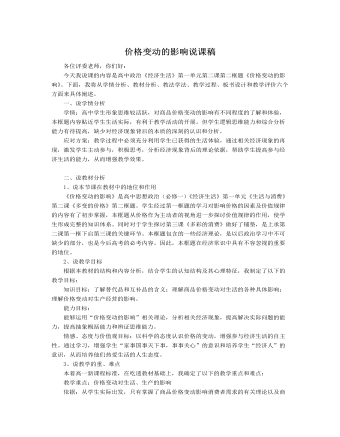
人教版高中政治必修1价格变动的影响说课稿
回归生活:近几年,我国市场上猪肉价格在不断地波动。请智囊团商议:我们集团如何才能避免重蹈“张老汉”的覆辙?学生活动:思考、发言、群策群力。教师鼓励学生从多角度分析,找出解决问题的不同方法。教师点拨:在猪肉价格波动较大时,我们除了调节生产规模,还可以采用引进新品种、加强科学管理等手段来提高劳动生产率,从而在价格竞争中更具优势。同时,我们要在激烈的市场竞争中站稳脚跟,还必须以市场为导向,生产适销对路的高质量产品,做到“人无我有,人有我优,人优我转”。教师引导学生分析:价格变动对生产规模的调节、对劳动生产率的提高及促使企业生产适销对路的高质量产品,就是在价格、供求关系及市场竞争的刺激下,价值规律发挥“棒子”(调节资源配置)、“鞭子”(鞭策个别劳动生产率的提高)及“筛子”(优胜劣汰)作用的结果,从而将本节课的内容与第一框题有机联系在一起,帮助学生从不同角度更深刻的理解价值规律的作用。
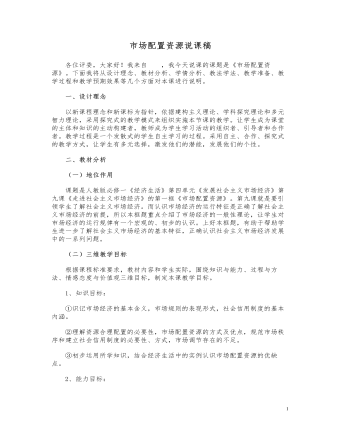
人教版高中政治必修1市场配置资源说课稿
(2)、市场调节存在固有的弊端:自发性:由于市场调节是在价值规律自发作用下进行的,在利益驱动下会产生一些违反市场原则的行为,如制造、销售假冒伪劣商品,大量排放废水、废气破坏环境,窃取他人智力成果等等。盲目性:由于人们不可能完全掌握生产各方面信息及其变化趋势,致使决策带有一定的盲目性。如某种商品有利可图则一哄而上,反之则一哄而退,从而造成资源浪费和消费得不到充分满足。滞后性:由于市场价格的形成和传递有一个过程,一旦传递到生产经营者手中进行生产调整,就有一个时间差,致使市场调节带有滞后性,成为一种事后调节。教师活动:请同学们想一想,市场的这些弊端和不足,会导致什么后果?(3)、危害教师总结:资源浪费,经济波动与混乱,分配不公两极分化等。设计意图:通过创设情景,加深对市场调节局限性的理解;要求学生结合生活实例探讨其弊端有助于加强对其产生原因和表现的记忆和理解。
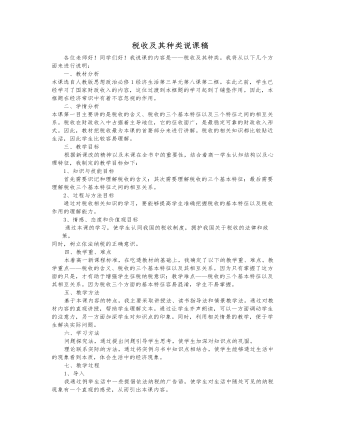
人教版高中政治必修1税收及其种类说课稿
在学生明确了税收的含义之后,我将分别对税收的三个基本特征进行解析。在讲解了之后,并分别用实例对其进行说明,加深学生对知识点的印象。最重要的是,总结出关键的字眼,使得学生能够清晰的区分出税收的三个基本特征。将强制性概括为依法征税、依法纳税;无偿性概括为不具有偿还性和返还型;固定性概括为规定应不应纳税、纳什么税、纳多少税。并跟学生指出,强制性是基本前提,无偿性是核心。由此根据书上的内容,推导出税收的三个基本特征相互之间的关系,即:三者缺一不可,统一于税法。而且,无偿性要求强制性,强制性保障无偿性;而无偿性与强制性又共同决定固定性。从而结束新课讲授。3、课堂总结根据板书内容重新回顾本课学习的主要内容,包括税收的含义,以及税收的三个基本特征和它们之间的相互关系。4、作业布置让学生预习税收的种类的内容,尤其是增值税和个人所得税。同时了解父母每月所缴纳的个人所得税和怎么计算的。
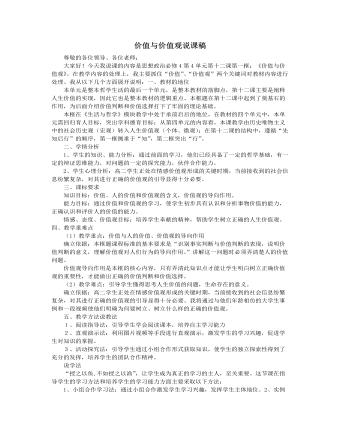
人教版高中政治必修4价值与价值观说课稿(一)
预测回答:成龙在影视,武术方面的价值,对于某个人,某个集团的价值。知识引导:人的价值体现在多方面的,可以是物质方面,也可以是精神方面,可以是对某个人或某个集团的价值,也可以是对人类和社会的价值。设置目的:从学生感兴趣的人物入手,分析对人的价值的评价。让学生自己分析总结,体现学生在新课改下的主体地位。从上述事例中我们可以看出人的价值是什么?如何评价?(学生活动)2.人的价值:在于创造价值,在于对社会的责任和贡献,即通过自己的活动满足自己所属的社会、他人以及自己的需要。(幻灯片显示)3.人的价值评价:看他的贡献,最根本的是对社会发展和人类进步事业的贡献。(幻灯片显示)老师总结:对社会的贡献并不是高高在上,不可触及。只要是做自己该做的事,从身边的小事做起,普普通通的劳动就是贡献社会和他人。学生归纳:人生价值原理二、价值观的导向作用(板书)1.价值观的含义人们在认识各种具体事物的价值的基础上,形成对事物价值的总的看法和根本观点。
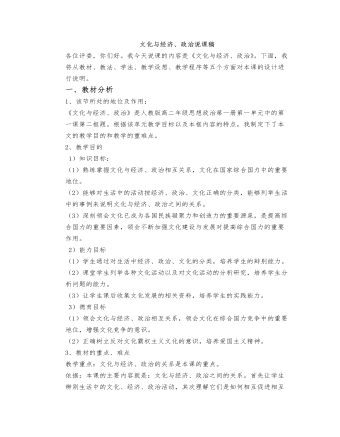
人教版高中政治必修3文化与经济、政治说课稿
(二)讲授新课:1、讲授重点:文化与经济、政治的关系。我首先带领学生分析课本上的活动探究,了解日常生活中的常见活动,让学生们观看视频材料帮助学生对文化活动、经济活动、政治活动进行辨别和分类。然后让学生们举例说明,综合探究,最后通过集体讨论得出文化与经济政治的关系:经济是基础,政治是经济的集中表现,文化是经济和政治的反映,一定的文化由一定的经济和政治决定,又反作用于政治和经济。这个问题是本课重点。要引导学生循序渐进,集体讨论,得出结论。2、突破难点:(1)文化与经济政治相互交融,在时代发展的进程中。首先播放上海世博会视频,让学生体会文化、经济、政治活动,另外我会引导学生积极举生活中的事例,来说明问题,让学生学会举一反三,充分理解这一知识,让学生明白文化与经济、政治的联系,让学生清楚文化渗透的力量有多大,帮助学生树立反对文化霸权主义的意识。
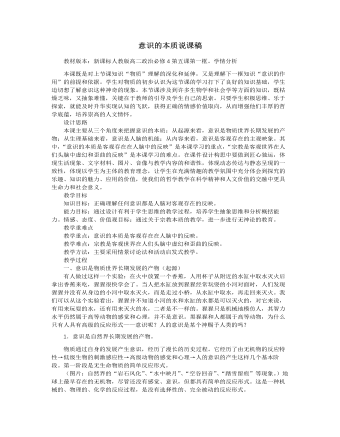
人教版高中政治必修4意识的本质说课稿
师:分析得非常到位。大家来看看薛宝钗是怎么说的?薛宝钗的评论:“不像吟月了,月字底下放一个‘色’字倒还使得,你看句句倒是月色。这也罢了,原来诗从胡说来,再迟几天就好了。”生:(读第三首诗)“精华欲掩料应难,影自娟娟魄自寒。一片砧敲千里白,半轮鸡唱五更残。绿蓑江上秋闻笛,红袖楼头夜倚栏。博得嫦娥应借问,缘何不使永团圆!”这首诗语言很朴实,但意境很深远。我虽然读过《红楼梦》这本书,也看过电视剧,但我阅历太浅,说不出诗中所包含的深刻内涵。师:贾宝玉的评论:“这首不但好,而且新巧有意趣,可知俗语说的‘天下无难事,只怕有心人。2.意识的形式是主观的意识是人脑对客观存在的反映,意识是不是仅仅是人脑对客观存在原原本本的反映呢?“龙、凤”是中华民族的象征,是炎黄子孙的两大主要图腾,但地球上从来就没有出现过“龙、凤”,那么“龙、凤”的观念又是从何而来的呢?原来,“龙、凤”的观念最早产生于原始社会的图腾崇拜。、
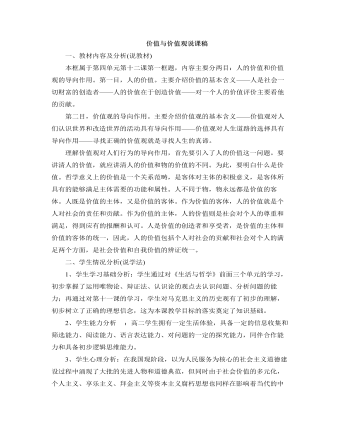
人教版高中政治必修4价值与价值观说课稿(二)
二、学生情况分析(说学法)1、学生学习基础分析:学生通过对《生活与哲学》前面三个单元的学习,初步掌握了运用唯物论、辩证法、认识论的观点去认识问题、分析问题的能力;再通过对第十一课的学习,学生对马克思主义的历史观有了初步的理解,初步树立了正确的理想信念,这为本课教学目标的落实奠定了知识基础。 2、学生能力分析 :高二学生拥有一定生活体验,具备一定的信息收集和筛选能力、阅读能力、语言表达能力、对问题的一定的探究能力,同伴合作能力和具备初步逻辑思维能力。3、学生心理分析:在我国现阶段,以为人民服务为核心的社会主义道德建设过程中涌现了大批的先进人物和道德典范,但同时由于社会价值的多元化,个人主义、享乐主义、拜金主义等资本主义腐朽思想也同样在影响着当代的中学生。
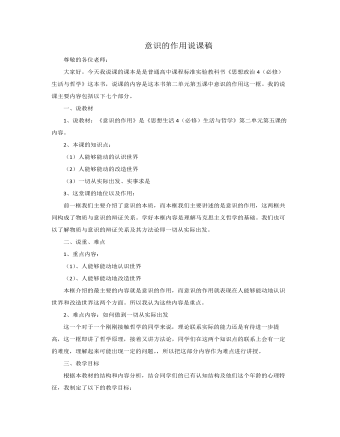
人教版高中政治必修4意识的作用说课稿(二)
(3)一切从实际出发、实事求是在讲授这部分内容时,同样继续利用长城的例子来说明,古人正是经过实地的考察得出最佳的建造地点等,结合了当地当时的实际来建造长城,引导学生得出从实际出发,实事求是的结论。3、课程小结:本节的所有内容已经讲授完毕了,为了让学生更好地巩固本节课所学的知识,我会利用板书为学生梳理本节的重点条框内容。这样能够帮助学生理清思路明确各知识点的关系。4、作业:我会要求同学在课后以某一个事例(如:一件事情、一栋建筑、一辆汽车等)为例,来写出着个事例中体现我们今天所讲课的内容的知识点。七、说教学理念我的教学理念是以传统的教授法与范例教学法就相结合的教学方法为主,充分利用多媒体的教学手段,结合事例来讲解知识,在上课过程中充分调动同学的积极性来讲解知识。我的说课完毕,不足之处望各位老师给予指正!
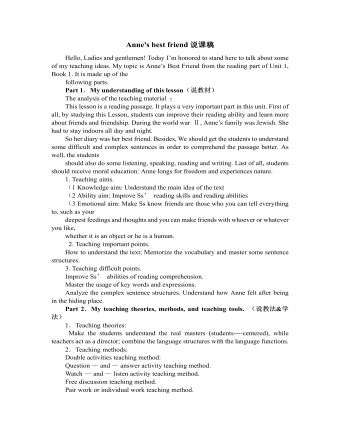
人教版高中英语必修1Anne's best friend说课稿
Step 7 Language points 1.Vocabulary (1) go through (2) set down (3) a series of (4) on purpose (5) in order to (6)at dusk (7)entirely (8)face to face 2.Important sentences (1)…I’ve grown so crazy about everything to do with nature. (2)There was a time when … (3)I stayed awake on purpose until … (4)It was the first time … that I’d seen the night … (5)It’s no pleasure looking through … Purpose: 1.Master the required vocabulary and sentence structures. 2.Use them freely. Step 8 Consolidation 1.Find out the topic sentences 2.Retell the text according to the topic sentences Purpose: I want to know if my students understand the text. Step 9 Discussion Imagine you have to go into hiding like Anne and her family, what would you miss most? Giveyour reasons. Purpose: Train Ss’ oral English ability. Step 10 Homework Write an article on Friends. Purpose: 1. Improve the Ss’ writing ability. 2 Train the Ss’ ability of self—teaching and looking up information by themselves. Part 5 Blackboard design(说板书设计)Unit 1 Friendship Reading Anne’s Best Friend 1.Main idea of each paragraph: Para. 1 Anne made her diary her best friend. Para .2 Anne wrote her feelings in her diary. Para .3 Anne missed nature. Para.4 Anne saw the night face to face Para.5 Anne wanted to experience nature outdoors. 2.Listening: Exx.1 P3 3.Discussion: Exx.3 P3 Purpose: 1.Make Ss familiar with the passage 2.Make the design inductive, instructive and artistic.
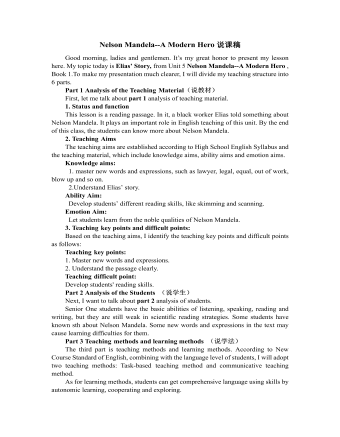
人教版高中英语必修1Nelson Mandela--A Modern Hero说课稿
In this step, give students a few minutes to read the passage . While they are reading, I will write some key words of the text on the blackboard. Then ask students to retell the passage according to the key words.By retelling, students can improve their ability of language organization and have an overall understanding of the article.Step 4 Group discussionIn this step, students will be divided into groups of 4 to discussion the following question: What qualities make a great person?After their discussion, invite a few groups to make a report to the class.This group discussion can practice students’ oral English and cultivate their abilities of cooperation and communication.Step 5. HomeworkLet students write a short passage to introduce a great person he or she admires.The homework can consolidate the knowledge the students have learned and cultivate their writing ability. Part 6 Blackboard Design(板书设计)That’s all my teaching procedures. Finally, I’d like to say sth about part 6 blackboard design. On the top is the title. On the left, there will be some new words and expressions. In the middle of the blackboard, I will write some useful sentence structures so that the students can know clearly what they’ve learned and then try to master the knowledge.OK. That’s all for my presentation. Thank you for your attention.

人教版高中地理必修1第二章第一节冷热不均引起大气运动说课稿
4、【自主探究】巴山夜雨的成因③材料三:三国时期,诸葛亮于农历6月的一天,在葫芦峪设下伏兵,打算用火攻全歼司马懿。这一天,晴空万里暑热难耐,真乃火攻之良机。诸葛亮依计将司马懿之众诱入谷中……然而,正当大火冲天,司马懿全军行将覆灭之时,一场大雨不期而至,大雨浇灭了诸葛亮扶汉反魏的壮志,使他喊出了“谋事在人,成事在天,不可强也”的千古悲歌。【设计理念】前后呼应,发散思维。通过自主探究,学生各抒己见,完成对热力环流整个知识框架的一个总结,既考查了学生的课堂学习效果,又锻炼了学生知识的迁移能力,并认识生活中的地理规律,用生动的语言拉近学生与大气理性知识的距离,体会到地理学科的重要性。【提问】如果将白天换成夏季,将夜间换成冬季,情况又会怎样?城市与郊区之间也存在着热力环流——城市风,它们是怎样形成的?了解城市风的出现有何重要意义?如果地球上在赤道和两极之间存在热力环流,这个热力环流应该怎样?这几个问题,请大家课后慢慢思考。
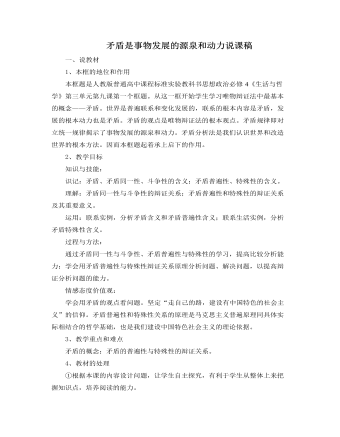
人教版高中政治必修4矛盾是事物发展的源泉和动力说课稿(二)
一、说教材1、本框的地位和作用本框题是人教版普通高中课程标准实验教科书思想政治必修4《生活与哲学》第三单元第九课第一个框题。从这一框开始学生学习唯物辩证法中最基本的概念——矛盾。世界是普遍联系和变化发展的,联系的根本内容是矛盾,发展的根本动力也是矛盾。矛盾的观点是唯物辩证法的根本观点。矛盾规律即对立统一规律揭示了事物发展的源泉和动力。矛盾分析法是我们认识世界和改造世界的根本方法。因而本框题起着承上启下的作用。2、教学目标知识与技能:识记:矛盾、矛盾同一性、斗争性的含义;矛盾普遍性、特殊性的含义。理解:矛盾同一性与斗争性的辩证关系;矛盾普遍性和特殊性的辩证关系及其重要意义。运用:联系实例,分析矛盾含义和矛盾普遍性含义;联系生活实例,分析矛盾特殊性含义。
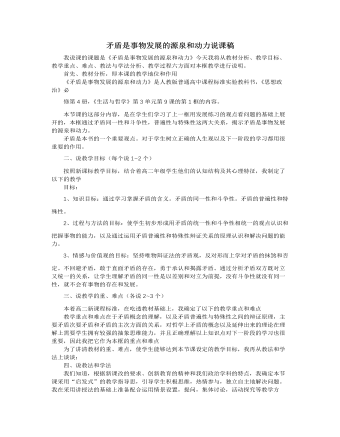
人教版高中政治必修4矛盾是事物发展的源泉和动力说课稿(一)
《矛盾是事物发展的源泉和动力》是人教版普通高中课程标准实验教科书,《思想政治》必修第4册,《生活与哲学》第3单元第9课的第1框的内容。本节课的这部分内容,是在学生们学习了上一框用发展练习的观点看问题的基础上展开的,本框通过矛盾同一性和斗争性,普遍性与特殊性这两大关系,揭示矛盾是事物发展的源泉和动力。矛盾是本书的一个重要观点。对于学生树立正确的人生观以及下一阶段的学习都用很重要的作用。二、说教学目标(每个说1~2个)按照新课标教学目标,结合着高二年级学生他们的认知结构及其心理特征,我制定了以下的教学目标:1、知识目标:通过学习掌握矛盾的含义。矛盾的同一性和斗争性。矛盾的普遍性和特殊性。2、过程与方法的目标:使学生初步形成用矛盾的统一性和斗争性相统一的观点认识和把握事物的能力,以及通过运用矛盾普遍性和特殊性辩证关系的原理认识和解决问题的能力。
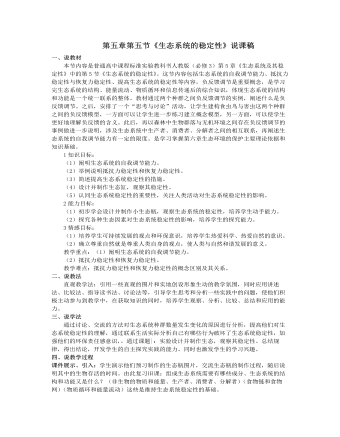
人教版高中生物必修3第五章第五节《生态系统的稳定性》说课稿
主要让学生明确以下观点:(1)自然生态系统是人类生存的基本环境;(2)人类活动的干扰正在全球范围内使生态系统偏离稳定状态;(3)人类生存与发展的命运就掌握在自己手中,但又受到自然规律的制约。反思总结,练习巩固:对本节知识点进行回顾,整理出简要的知识主线,为学生系统性复习巩固提供思路,课件展示老师课前收集准备的相关练习题,指导学生完成练习题,加学生深对本节知识的理解把握。结课布置作业:我们已经学习了生态系统的稳定性,那么,生态系统的各种功能之间的关系是怎样的呢?在下一节课我们一起来学习这一方面的内容。这节课后大家可以先预习这一部分,着重分析他们之间的关系。并完成本节的课后练习及课后延伸拓展作业。达到对本节内容知识的巩固提高和延展的目的。八、板书设计第五节生态系统的稳定性一、 生态系统的稳定性概念1.概念:生态系统所具有的保持或恢复自身结构和功能相对稳定的能力,
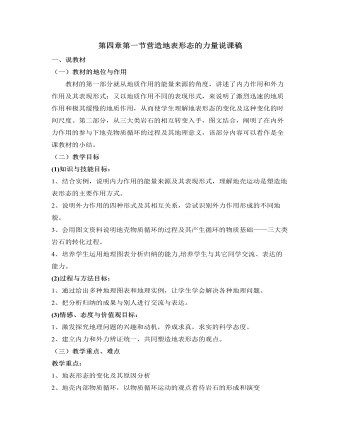
人教版高中地理必修1第四章第一节营造地表形态的力量说课稿
(一)教材的地位与作用教材的第一部分就从地质作用的能量来源的角度,讲述了内力作用和外力作用及其表现形式;又以地质作用不同的表现形式,来说明了激烈迅速的地质作用和极其缓慢的地质作用,从而使学生理解地表形态的变化及这种变化的时间尺度。第二部分,从三大类岩石的相互转变入手,图文结合,阐明了在内外力作用的参与下地壳物质循环的过程及其地理意义,该部分内容可以看作是全课教材的小结。(二)教学目标(1)知识与技能目标:1、结合实例,说明内力作用的能量来源及其表现形式,理解地壳运动是塑造地表形态的主要作用方式。2、说明外力作用的四种形式及其相互关系,尝试识别外力作用形成的不同地貌。3、会用图文资料说明地壳物质循环的过程及其产生循环的物质基础——三大类岩石的转化过程。4、培养学生运用地理图表分析归纳的能力,培养学生与其它同学交流、表达的能力。

